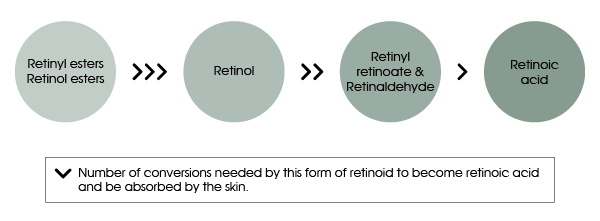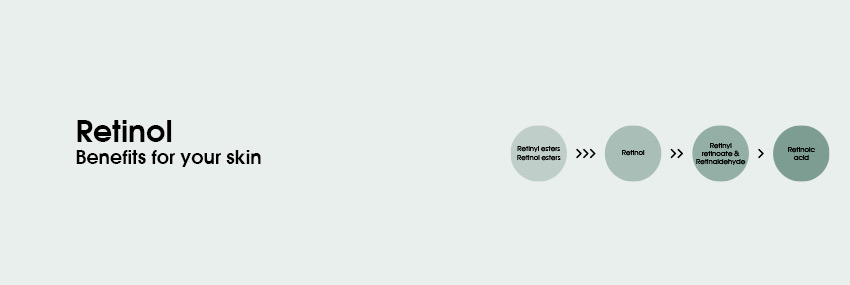Wait, you don’t use retinoids yet? They’re amazing actives to include in your night skincare routine! They help you prevent and reduce wrinkles and fine lines, blemishes and acne. There are many retinoid skincare products, but after reading this guide you’ll certainly know how to choose the best for you (and how to use it)!
Hi there! How are you? Today, following the path of my guides on acids, vitamin C and hyaluronic acid, I am going to talk about another of the great ingredients in skincare: retinol and how it can help us incorporate it into our routines of beauty. It is a very common ingredient in cosmetics, although we should be aware of its strength. With this article I hope you get to know it a little better and understand what it can provide you if you use it properly.
Specifically, in this article I will deal with the following topics:
- What is retinol? What is retinol used for?
- Is retinol the same as retinoids? What retinoids are there?
- When can I start using retinoids?
- The best skincare products with retinoids.
1. WHAT IS RETINOL? WHAT IS RETINOL USED FOR?
Retinol is a derivative of vitamin A (as well as the rest of retinoids, which I will talk about later), and is the cosmetic ingredient with the most studies guaranteeing its effectiveness. In the 1960s it was used as a solution for acne, and over the years it gained popularity for its effectiveness in improving wrinkles and expression lines. It is a very powerful ingredient that can give us excellent results when it comes to preventing the signs of aging, but its use requires us to be cautious and use it properly.
As I mentioned before, the first use of retinol in cosmetics was to reduce acne, which showed the most effective results. It is possible that during adolescence your dermatologist prescribed some medication with retinol, since among its properties we find that it helps rebalance the oil levels of the skin, thus helping to reduce pimples and providing skin with a more uniform texture.
Retinol is also known to be a powerful anti-aging ingredient. What does this mean? On the one hand, it helps us to reduce wrinkles and expression lines, since it facilitates the repair of collagen and elastin fibers, in charge of maintaining skin firmness. In addition, since it accelerates the process of cell turnover, our skin produces new cells more quickly, so that it regenerates earlier and increases its elasticity. An important aspect to keep in mind is that this cell renewal can cause a purge, meaning that our skin will get rid of its dead cells and excess oil, and then reset itself. If you want to read more about how our skin works, you can take a look at this other article.
Finally, retinol also helps reduce skin spots and improve skin tone, since it inhibits the production of melanin, although if you are looking to reduce skin blemishes, what I advise you is to incorporate an acid into your skincare routine (in this article I talk in more detail about them), since they provide better results.
2. IS RETINOL THE SAME AS RETINOIDS? WHAT RETINOIDS ARE THERE?
Retinol is, in fact, a type of retinoid. All the derivatives of vitamin A that we can find in our cosmetics are retinoids, and there is a great variety of them. To understand which ones are more effective or powerful, we must bear in mind that the way vitamin A occurs naturally in the skin is as retinoic acid, so that all the retinoids that we apply will have to go through a series of transformations (or conversions) until they become retinoic acid, it is at that moment that the skin can absorb and use it. Retinoic acid will be the one that helps us obtain all those results that I talked about in the previous part of the article: reducing acne, reducing wrinkles and expression lines, improving firmness and elasticity, etc. The cosmetics we use can include different types of retinoids, the more they resemble retinoic acid (and therefore the fewer conversions they need), the more potent (and potentially irritating) they are.

Let’s see what type of retinoids we can find based on the necessary conversions so that they become retinoic acid and can be absorbed by the skin:
Retinyl esters / Retinol esters:
These retinoids are very frequent in cosmetics and, as you can see in the graph, three conversions are necessary to transform them into retinoic acid. This makes them less powerful ingredients (so it takes more time to see results), but also less irritating.
In the ingredient lists you will find them as Retinyl palmitate, Retinyl acetate, Retinyl propionate or Retinyl linoleate.
Retinol:
This is the retinoid with the largest number of studies that support its effectiveness in reducing wrinkles and expression lines and increasing collagen levels. Two conversions are necessary to transform into retinoic acid, and in the ingredient lists you will find it as Retinol.
Retinaldehyde and Retinyl retinoate:
These ingredients only require one conversion to become retinoic acid. They are very effective in reducing expression lines and deep wrinkles, although they are potentially irritating (although less than other more powerful derivatives). In the ingredient lists you will find them as Retinal, Retinaldehyde or Retinyl retinoate.
Retinoic acid / Trans-retinoic acid:
This is undoubtedly the most powerful ingredient of all that we will see in this article, but also the most irritating. As I mentioned before, all the retinoids that I have talked about so far have to be transformed into retinoic acid so that the skin can absorb and use them for the effects that we seek. In many countries it cannot be purchased without a prescription. It goes by different names, such as Tretinoin, Retin-A, Retirides, or Isotretinoin.
New retinoids:
In addition to the ones I have mentioned so far, also known as first generation retinoids, there are more recent ones, known as second, third and fourth generation retinoids. These new retinoids are characterized by being newly created, and there are not yet many scientific studies analyzing their efficacy. Among them we find Adapalene (a synthetic form of tretinoin -retinoic acid- very powerful and somewhat less irritating than retinoic acid itself), Tazarotene (similar to retinoic acid but more irritating, used in medical treatments for psoriasis) and, perhaps the best known, the Hydroxypinacolone Retinoate, better known as Granactive Retinoid, which you will probably remember from my review of this serum from The Ordinary, it does not need conversions to become retinoic acid (something very interesting in terms of efficacy) but it provides a very low potential risk of irritation.
As you can see, there is a wide variety of retinoids, so it is easy to introduce it little by little to our beauty routines, starting with products with a lower concentration of mild retinoids and increasing the dose progressively for greater effectiveness.
Bakuchiol: an alternative to retinol?
Bakuchiol is an active ingredient that has been gaining a lot of presence in cosmetics over recent years. The potential benefits of bakuchiol seem promising due to its ability to promote collagen synthesis and prevent the degradation of its fibers, as well as its anti-inflammatory and antioxidant action (which is associated with its ability to reduce certain skin spots).
Sometimes you will see that there are references to it as an alternative to retinol that can give you the same results but with less potential irritation. Truth is that, at the moment, there are not enough studies to support the effectiveness of bakuchiol and most of those that exist have been carried out in vitro, so there is still a long way to go before we can assess whether these actives can really be compared. Some even go so far as to claim that Bakuchiol is safe during pregnancy (unlike retinoids), but there are no studies on the subject. On the other hand, it must be taken into account that bakuchiol is obtained from the seeds of an endangered plant, so the extensive use of this ingredient in cosmetics can be a real environmental problem, so a sustainable way to get it is necessary.
If you want to give this active ingredient a try, you can find it in this moisturizer from The Inkey List and in this other product from Paula’s Choice.
3. WHEN CAN I START USING RETINOIDS?
This question does not have a closed answer. As with all other skincare ingredients, the right time to start using them is when your skin asks for them.
As I commented at the beginning of the article, retinol provides excellent results when it comes to improving acne and reducing wrinkles and fine lines, so if these are your concerns, you can consider incorporating it into your beauty routines. Generally speaking, if you want to prevent wrinkles and fine lines, from the age of 25-30 you may be interested in starting to incorporate retinoids into your skincare routines, since at these ages the levels of collagen and elastin begin to decrease (them being responsible for keeping our skin firm) and, through these retinoids, we help prevent the signs of aging.
What you should take into account if you want to start using retinol is that it is not advisable to begin with a powerful one, as this can cause significant irritation to the skin and the negative consequences will outweigh the positive ones. If you decide to incorporate retinoids into your skincare routines, you must think that the results won’t be noticeable overnight, so you have to assume that they will be part of your routines for a long time.
My advice is to start once or twice a week with a product that incorporates a lower concentration of a milder retinoid (like Retinyl palmitate, some other retinol ester, or the Granactive Retinoids I mentioned earlier). In this way, your skin can begin to acquire tolerance, getting used to the presence of retinol in your beauty routines and assimilating it correctly. Later, you can increase the dose of retinol, either with higher concentrations in the way you were using or moving to another retinoid that requires fewer conversions to transform into retinoic acid.
I want to stop for a moment to reflect on retinol and its adverse effects. Although, as we have seen, it is a very effective ingredient and it can give us very good results, abusing it or wanting to start with very strong doses can be harmful. Some possible side effects include dry skin, flaking, redness and increased photosensitivity. Therefore, if you dare to start using retinoids there are certain indications that you should take into account.
- First of all, for retinoids to be effective you will need a good skin barrier, so your skin must be well cared for, nourished and hydrated.
- You should start with lower doses and gradually increase them, allowing your skin to generate tolerance. Sometimes a higher dose of retinoids can give you more side effects than benefits, so you should research what is your ideal concentration.
- You should always apply them in your night routines.
- When you apply retinoids it is not convenient to have damp skin, so you must apply the serum on a dry skin.
- Of course, even if you already do it regularly, you should use a good sunscreen in the morning (here you can read a comparison of sunscreens in case you still have not found yours).
- As with all other beauty products, before starting to incorporate retinoids into your routines, you should do the patch test to make sure that your skin tolerates them properly.
- You should not use retinoids at the same time as other powerful and potentially irritating actives such as acids, which I already told you about in this article.
- Finally, you should keep in mind that retinoids should not be used in summer (or in times when you are exposed to a lot of ultraviolet radiation) or during pregnancy or lactation.
4. THE BEST SKINCARE PRODUCTS WITH RETINOIDS.
You probably remember this serum from the review I shared about it. This is one of my favorite products when starting to use retinoids. Its composition, from a new generation retinoid, makes it a product of moderate efficacy but does not irritate at all, so it can be used even if you have sensitive skin. In this way, our skin can begin to acquire tolerance to retinoids easily.
You can get the serum The Ordinary Granactive Retinoid 2% Emulsion at DECIEM (recommended).
I have really enjoyed using this serum from Medik8. In this case, in its composition we can observe the presence of Retinal, which only requires a conversion so that the skin can assimilate it. In addition, it incorporates squalane and hyaluronic acid to improve skin hydration and help us strengthen the skin barrier. Finally, among its ingredients we also find a derivative of vitamin C (3-O-Ethyl Ascorbic Acid), so those benefits that retinol can bring us when it comes to reducing stains can be multiplied. Even though it contains fragrance among its ingredients, its effectiveness and its texture make it one of my absolute favorite skincare products.
I really like how this product has a great balance of strength and gentleness. Once my skin grew a high tolerance to retinoids, I could use this almost on a daily basis while keeping my skin barrier healthy. Among its ingredients we find Retinol (so two conversions will be necessary for it to transform into retinoic acid), various types of peptides (which also help us to improve wrinkles and expression lines), vitamins C and E (two great sources antioxidants) and ceramides (which help us improve hydration and keep the skin barrier protected).
You can get the Paula’s Choice Clinical 1% Retinol Treatment on Paula’s Choice and on Niche Beauty.
In this case, the team at Allies of Skin have developed a sleeping mask (which works as a nourishing moisturizer) that not only includes Retinal (which, as you will remember, is one of the most effective forms of retinoids), but also incorporates niacinamide (which facilitates the absorption of said Retinal itself), as well as various forms of peptides (which, together with retinoids, help us achieve a better result when it comes to reducing wrinkles and expression lines). What I like most about this type of mask is that you do not have to rinse it, but you use it as the last step of your night routine and in the morning you can just normally do your skincare routine.
You can get the Allies of Skin 1A Retinal + Peptides Overnight Mask on Niche Beauty.
I’m just starting to incorporate this La Roche-Posay serum into my skincare routines. In this case, from La Roche-Posay they have developed a product based on Retinol and Retinyl Palmitate (which makes it a good option if you want to start incorporating retinoids into your routines). In addition, among its ingredients we also find niacinamide (to facilitate the assimilation of retinol), hyaluronic acid (to improve the hydration of our skin and thus keep it well protected) and vitamin E (a great source of antioxidants).
You may wonder, and what is this niacinamide serum doing here if we are talking about retinol? I have added it because, as I mentioned before, niacinamide helps the skin to better assimilate retinoic acid, so you can include a serum like this in the same routine to make it even more effective or for that reason, as you have seen before, some retinoids also incorporate niacinamide among their ingredients. If you want to know more about this serum you can read its full review here.
You can get The Ordinary Niacinamide 10% + Zinc 1% on DECIEM (recommended).
I hope this article has helped you to understand a little better how retinol works and everything it can contribute to your beauty routines. If you have any questions, do not hesitate to leave me a comment and I will reply as soon as possible.
If you liked this article and want to continue learning about cosmetics and skincare, you will be interested in reading these others:
Do you want to learn to take better care of your skin? You can see an index of all my informative posts here.*I have received some of these products as PR | Read more about my transparency code.
● Follow me on Instagram, Facebook, TikTok and Pinterest.
● Share, comment and like my posts on social media.
● Shop through my links to help me keep up with this blog.

I’m Nacho and I’m passionate about skincare. I really enjoy learning and sharing my knowledge about skincare and I read scientific papers so you don’t have to. I want to break stereotypes because I believe skincare has no gender: skin is skin.



Gracias por este post tan informativo, Nacho. Como alguien que tenía un poco de “miedo” a empezar a usar este ingrediente, te lo agradezco mucho. Que sigas muy bien, saludos!
Hola Luis!
Me alegro mucho de que te haya gustado el post 😊 El retinol es un ingrediente que está de moda hoy en día pero que no debe tomarse a la ligera para que nuestra piel no se resienta, mejor empezar lento pero seguro y que nuestra piel adquiera tolerancia progresivamente.
Que tengas un buen día!
Nacho.